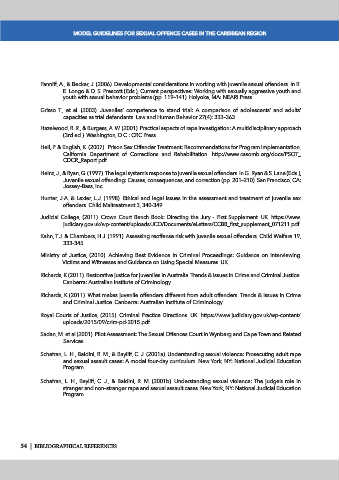Page 654 - Magistrates Conference 2019
P. 654
MODEL GUIDELINES FOR SEXUAL OFFENCE CASES IN THE CARIBBEAN REGION
Fanniff, A., & Becker, J. (2006). Developmental considerations in working with juvenile sexual offenders. In R.
E. Longo & D. S. Prescott (Eds.), Current perspectives: Working with sexually aggressive youth and
youth with sexual behavior problems (pp. 119–141). Holyoke, MA: NEARI Press.
Grisso T., et al. (2003). Juveniles’ competence to stand trial: A comparison of adolescents’ and adults’
capacities as trial defendants. Law and Human Behavior 27(4): 333–363.
Hazelwood, R. R., & Burgess, A. W. (2001). Practical aspects of rape investigation: A multidisciplinary approach
(3rd ed.). Washington, D.C.: CRC Press.
Heil, P. & English, K. (2007). Prison Sex Offender Treatment: Recommendations for Program Implementation.
California Department of Corrections and Rehabilitation. http://www.casomb.org/docs/PSOT_
CDCR_Report.pdf
Heinz, J., & Ryan, G. (1997). The legal system’s response to juvenile sexual offenders. In G. Ryan & S. Lane (Eds.),
Juvenile sexual offending: Causes, consequences, and correction (pp. 201–210). San Francisco, CA:
Jossey–Bass, Inc.
Hunter, J.A. & Lexier, L.J. (1998). Ethical and legal issues in the assessment and treatment of juvenile sex
offenders. Child Maltreatment 3, 340-349.
Judicial College, (2011). Crown Court Bench Book: Directing the Jury - First Supplement. UK. https://www.
judiciary.gov.uk/wp-content/uploads/JCO/Documents/eLetters/CCBB_first_supplement_071211.pdf
Kahn, T.J. & Chambers, H.J. (1991). Assessing reoffense risk with juvenile sexual offenders. Child Welfare 19,
333-345.
Ministry of Justice, (2010). Achieving Best Evidence in Criminal Proceedings: Guidance on Interviewing
Victims and Witnesses and Guidance on Using Special Measures. UK.
Richards, K (2011). Restorative justice for juveniles in Australia. Trends & Issues in Crime and Criminal Justice.
Canberra: Australian Institute of Criminology.
Richards, K (2011). What makes juvenile offenders different from adult offenders. Trends & Issues in Crime
and Criminal Justice. Canberra: Australian Institute of Criminology.
Royal Courts of Justice, (2015). Criminal Practice Directions. UK. https://www.judiciary.gov.uk/wp-content/
uploads/2015/09/crim-pd-2015.pdf
Sadan, M. et al (2001). Pilot Assessment: The Sexual Offences Court in Wynberg and Cape Town and Related
Services.
Schafran, L. H., Baldini, R. M., & Bayliff, C. J. (2001a). Understanding sexual violence: Prosecuting adult rape
and sexual assault cases: A model four-day curriculum. New York, NY: National Judicial Education
Program.
Schafran, L. H., Bayliff, C. J., & Baldini, R. M. (2001b). Understanding sexual violence: The judge’s role in
stranger and non–stranger rape and sexual assault cases. New York, NY: National Judicial Education
Program.
54 | BIBLIOGRAPHICAL REFERENCES

